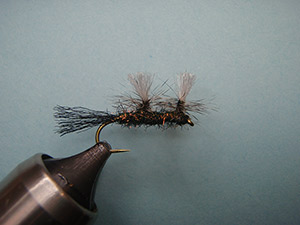Yellow Stimulator

RANDALL KAUFMANN Translated by CARL WUEBBEN
The two largest stonefly species, the salmon fly and golden stone are the most important hatches in the order. Both are predominantly western. Many other groups, including little brown stones, yellow sallies, and olive sallies, are important in the east, the west, and everywhere in between. All stoneflies live only in moving water. It’s important to fish the correct imitation whenever a stonefly species is on the water in good numbers. Trout key in on them and refuse everything else. It’s also important to know that some stonefly dressings, such as Randal Kaufmann’s stimulator, when tied in smaller sizes will also take trout during caddis and grasshopper activity. They make excellent searching dressings.
PATTERN
HOOK – 3x or 4x long, sizes 4-6-8-10-12.
THREAD – 6/0 hot orange.
TAIL – Light elk hair.
RIB – Fine gold wire, counter wound over the body hackle.
BODY HACKLE– Brown, undersize.
BODY – Yellow fur or synthetic dubbing.
WING - Light elk hair.
HACKLE – Grizzly wound over thorax.
THORAX – Amber fur or synthetic dubbing.
HOW TO TIE
- Debarb hook – mount in vise – start your thread two eyelets space from the eye of the hook and lay a thread base toward the bend of the hook shank and end just before the bend. Clip off a hunk of elk hair about the two to three times the thickness of the hook shank depending on the size of the hook, clean the fuzz out and then align the tips in a hair stacker then tie in at the rear of the hook shank, (This is your tail) the tail should be about half the length of the shank, then wrap the butt end down on top of the shank and end it about four of five eyelet’s from the eye and clip off the tag ends at a 45 degree angle, then go back to the rear of the shank with tight wraps, to hold the hair down.
- Tie in three to four inches of gold ribbing wire at the base of the tail. (This will protect your body hackle), with the longer piece toward the bend of the hook (We will counter wrap this later). Put this in your material clip.
- Select a long brown hackle, either neck or saddle, with fibers just one hook gap long, strip the fluffy stuff off the lower part of the stem, and tie it in by the butt section of the feather at the base of the tail, with the concave side toward you so the fibers lean a bit forward when wound. Twist some yellow dubbing onto the thread for your body (abdomen), and wind a stout, untapered body over the rear two thirds of the hook shank.
- Wind the brown body hackle forward in evenly spaced wraps to the end of the body (Where dubbing ended). Tie off and clip off your tag end. Make sure to leave plenty of room for the wing and final hackle. Counter wind the ribbing wire through the body hackle. Wobble the wire back and forth as you wind it to prevent knocking down too many hackle fibers, though you’ll always catch a few.
- Select a patch of elk hair about twice the thickness of the tail, clip it from the hide, clean the fuzz from the butts, and align the tips in your hair stacker. Hold the wing in a firm pinch in your tying hand (Right handed person it’s your right hand), and measure it to the end of the tail. When tied in, you want the end of the wing to stand either even with or just short of the end of the tail. The tail, when the fly is on the water, represents the back end of the wing, not the actual tails of the insect, which are insignificant to an imitation.
- Transfer the wing pinch to your other hand and hold the wing tie-in point firmly in place at the end of the body (Front of abdomen dubbing- So it won’t spin). Tie in the wing with several loose thread wraps forward over the flared hair butts. Gather the butts and clip them on a 45 degree angle (So they don’t leave a step- that makes it hard to make the head).With firm wraps, Cover them with thread all the way up to the eye.
- Select a single grizzly feather or two neck hackles with fibers one and a half to two hook gaps long, strip the fluff from the bottom of the feather. It you’re using one saddle, tie it in with the concave side toward you so the fibers tilt forward when wound. If you use two neck hackles, pair them back-to-back so the fibers are well spread when wound. Tie in at front of wing.
- Dub a small noodle of amber fur for the thorax and wind it on to just behind the eyelet, and with a slight taper toward the front. Spiral the grizzly hackle forward and tie off just behind the eye and clip your tag end off. Build a small thread head and whip finish.
- Tie up a bunch - then take a photo of your best one and e-mail it to me and I can critique it for you if you want.
*** But remember to practice C.P.R. (CATCH – PICTURE – RELEASE).





